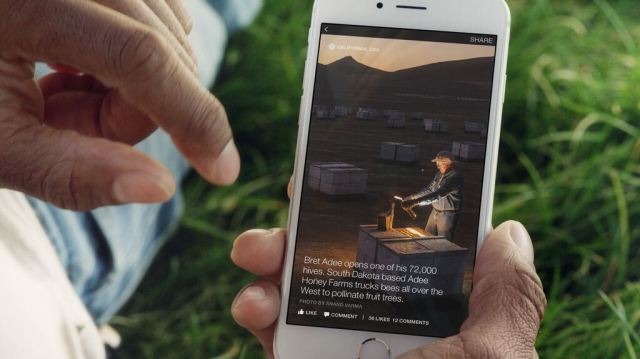Washington Post‘s Facebook Deal, Ad Blocking’s Winners and Losers, Making News Digestible, Audiences for Mobile Websites vs. Mobile Apps, Articlization and Mobile Snacking, TFP’s Infographic Pick of the Week, DPS 2015 Tip: Creating Roles and Permissions
Welcome to Technology for Publishing’s roundup of news and tips for media industry pros! This week, we’re sharing stories about The Washington Post‘s plan to publish all of its daily content to Facebook’s Instant Articles, winners and losers in the age of ad blocking, how top media outlets are “slimming down” news for readers, a comScore study on mobile apps vs. website audiences, and more.
- When The Washington Post announced it’s going “all in” on Facebook’s Instant Articles, it meant just that: It plans to run every one of the approximate 1,200 stories it publishes each day on the social platform. According to Recode, the deal comes as Facebook continues to ramp up its hosting program, which until now has had nine media outlets, including The New York Times, BuzzFeed, and the Guardian, publishing “hundreds” of articles a day. Though only 12.5% of the service’s iPhone users currently have access, the company plans to expand that significantly and offer service to Android users as well, according to the report. In addition, it has signed on other new partners, including The Huffington Post, Mashable, Hearst, and Vox Media. But the question remains: Is this the right strategic decision for publishers? See Fortune columnist Mathew Ingram’s look at the case for and against the direct-to-social model and a related post from James Breiner on the International Journalists’ Network.
- There’s no avoiding it. “Ad blockalypse,” as Digiday calls it, is upon us as more and more users take advantage of content blocking tech to counter poor readability on cluttered, sluggish sites. What does that mean for publishers? As we’ve covered here before, that depends. Digiday offers its take in a recent report on who wins and who loses in the ad blocker tussle. On one side, it says, big platforms stand to gain in their efforts to lure publishers with, among other things, faster load times (read Business Insider’s report on Goldman Sachs’ prediction that the digital advertising industry will be “fundamentally restructured” by Apple, Google, and Facebook). Other winners include readers and ad block app makers, of course, as well as publishers with diversified business models that include native advertising, which isn’t affected by ad blocking tech. On the loser side are small publishers that have to rely on inexpensive programmatic ads because they can’t afford sponsored content, as well as ad networks that may “get cut out of the equation,” the report notes. And while users get the benefit of a better reading experience, they could lose too, because free access to premium content will disappear if publishers go out of business.
- It goes without saying that readers face information overload when it comes to parsing the multitude of news sources available to them today. Publishers, of course, know this and—particularly with the rise of mobile—are focused on making their content more manageable, offering bite-size summaries, digests, Q&As, and the like. With this trend in mind, Nieman Lab takes us inside BuzzFeed, The Economist, The New York Times, Quartz, Vox, and Yahoo News to find out how they “slim down” the daily news for their readers, highlighting everything from curation models to app design to newsletter strategies. The report provides an inside look at the nuts and bolts of daily news churn at these top organizations and how they’re responding to audience and market shifts, making it a great read for all staff involved in content delivery.
- Here’s an interesting find from comScore: While users spend most of their time in mobile apps these days, websites have bigger audiences. Citing the study, The Wall Street Journal says smartphones now account for 62% of total time spent online, and of that, 44% of time is spent using smartphone apps. Far surpassing time spent on tablet apps and mobile websites, mobile users spend more than 70% of their time in smartphone apps, it notes. However, the comScore data shows the audience for mobile websites is about 2.5 times larger than for mobile apps—and it’s expanding twice as fast. Adam Lella, an analyst at comScore, explains in the report: “Because of fluid linking of content on social and search, it’s easier to attract audiences on the web. It’s just harder to keep them there for long periods of time.” The research firm found that of the 10 most-visited mobile apps, Facebook and Google own eight.
On the Technology for Publishing Blog
- In her latest article, TFP CEO Margot Knorr Mancini takes a look at the move toward articlization and so-called mobile snacking, noting that content structure and organization are key to successfully shifting to this go-anywhere, real-time delivery model.
- To help you develop your mobile strategy, TFP’s Infographic Pick of the Week brings you the results of a recent study on mobile usage across generations.
- Also, in this week’s Adobe Digital Publishing Solution Tip, Monica Murphy explains how to create and organize roles and permissions, making it easier to add and manage users when building DPS 2015 apps.
- ICYMI: Check out our September Book Picks for more insights on articlization in a mobile world.
Image: Recode/Facebook
Check out our blog for highlights of interesting and noteworthy stories from the publishing world every Friday, and sign up for TFP’s This Week in Publishing newsletter. Think we missed something great? Let us know! Leave a comment below or drop us a note.
Posted by: Monica Sambataro





